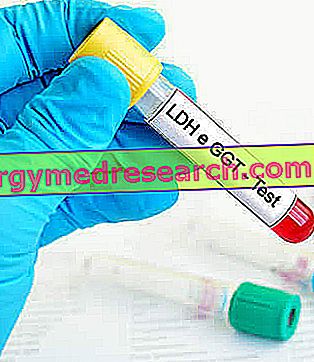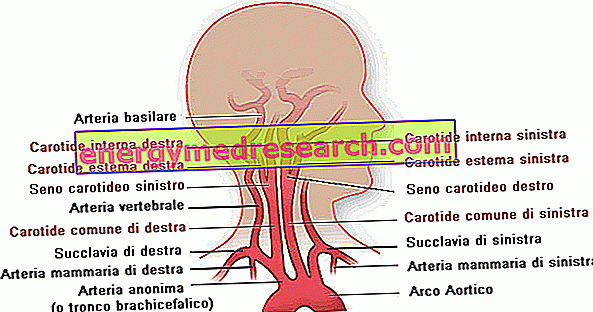Generality
Transaminases are a group of enzymes present in various tissues, but concentrated mainly in liver cells. In this location, they regulate deamination, ie they catalyze the reaction that removes the amino group from the amino acids (necessary, for example, to transform excess amino acids into energy).

- Lactate dehydrogenase ( LDH or lactic dehydrogenase ) is an enzyme found in the myocardium, skeletal muscles, liver, kidneys, pancreas, erythrocytes and lungs. In these locations, it is used by the body to metabolize sugar and make it available as energy usable by cells.
- Gamma glutamyl transpepetidase ( gamma-GT or GGT ) is an enzyme contained in many tissues, including liver, small intestine, spleen, pancreas and kidneys. This parameter is particularly useful for assessing the health status of the liver and biliary tract.
What's this
LDH (lactic dehydrogenase)
It is an enzyme that catalyzes the oxidation of lactic acid to pyruvic acid. It is contained in numerous tissues, especially those with active metabolism of glucose, such as muscle, liver, heart and kidney. For this reason, it is not a very sensitive index of hepatocellular alteration, being able to increase also during myocardial infarction, necrosis of skeletal muscles, haemolytic anemias, leukemias and neoplastic processes, as well as in the course of acute and chronic liver diseases.
Human serum contains a small amount of LDH, probably from normal cell lysis and erythrocytes (red blood cells), and its level increases significantly due to injuries to various organs and tissues. Its normal values are between 80 and 300 mU / ml.
Gamma-GT (gamma glutamyl transpepetidase)
It is the enzyme that catalyzes the transfer of gamma-glutamine radicals from different peptides, primarily from glutathione, to other peptides, thus intervening in the metabolism of glutathione to favor the detoxification of drugs in the liver. Furthermore, its biological role also appears to be that of transporting amino acids across cell membranes.
The human tissues in which it is most present are kidney, pancreas, intestine and liver (it is found in high concentrations both in the hepatocyte and in the bile ducts, for this it is considered a specific enzyme of the liver); high levels are also provable in bile, seminal fluid, serum and urine.
It should be remembered that, in the healing phase of acute hepatitis, the gamma-GT are the last enzymatic activities that normalize.
The normal values are slightly different in the two sexes (in men 5-36 mU / ml and in women 4-23 mU / ml).
Why do you measure
The dosage of LDH and GGT transaminases is mainly used when the doctor suspects a malfunction or injury to the liver, myocardium or other muscles.
Normal values
- LDH : 80-300 mU / ml.
- GGT : in humans 5-36 mU / ml and in women 4-23 mU / ml.
The reference values of transaminases LDH and GGT may change according to age, sex and instrumentation used in the analysis laboratory. For this reason, it is preferable to consult the ranges listed directly on the report. It should also be remembered that the results of the analyzes must be assessed as a whole by the medical doctor who knows the patient's medical history.
LDH and GGT Alte - Cause
LDH High
Even a small tissue damage is sufficient for the total activity of LDH to increase in serum. This increase occurs in a wide variety of diseases, such as:
- Myocardial infarction : the LDH released by cardiac cells in necrosis shows an increase in serum after about 12-24 hours from the beginning of clinical symptoms. This increase reaches the peak of maximum activity after 48-72 hours and the level remains high for 7-10 days. Sometimes, when the infarct is complicated by congestive heart failure, in addition to the increase in LDH derived from the heart muscle, there is also an increase in LDH from the liver damaged by the phenomena of blood stasis that occur in the liver.
- Pulmonary infarction : generally, in the acute one the LDH has a remarkable increase in activity, unlike other parameters such as CK and AST.
- Pulmonary embolism : it can often be confused with myocardial infarction because it has similar clinical symptoms.
- Lesions, traumas and muscular dystrophies : an increase in LDH occurs in the serum of patients with muscle disorders and this increase is more marked in the case of Duchenne muscular dystrophy (DMD).
- Liver diseases : in acute and extensive lesions, such as viral hepatitis, in the exacerbation of chronic diseases, in acute intoxications, in hepatic stasis following right heart failure, in hepatic necrosis from toxic agents and in chronic liver diseases there is always an increase in LDH .
- Renal disease : only rarely there is an increase in serum LDH, while in the urine of subjects with renal ischemia it is frequent to increase it.
- Neoplasms : in malignant tumors, the increase in LDH is due both to an increase in cell proliferation (which consequently also leads to an increase in their lysis), and to an increase in glycolysis by neoplastic cells, and for the presence of the liver metastases that many tumors cause.
- Pernicious Anemia : is a megaloblastic anemia (red blood cells are larger than normal) due to a deficiency of vitamin B12 or folic acid, especially if left untreated. There is also a correlation between serum LDH levels and anemia severity. The other enzymes, expression of hepatic or muscular lesions (transaminases, CK), are at normal levels. After the start of treatment with vitamin B12 or folate, the total serum LDH values tend to normalize rapidly.
- Hemolytic anemias.
An increase in lactate dehydrogenase concentration may be due to some drugs, such as: anabolic steroids, anesthetics, aspirin, alcohol, narcotics and clofibrates.
GGT High
Gamma Glutamil Transferase is increased in most diseases that cause damage to the liver or biliary tract, such as:
- Hepatitis of viral origin;
- Cholestatic disorders;
- Cirrhosis;
- Steatosis (fatty liver);
- Obstructive jaundice;
- Damage from hepatotoxic drugs and chemicals;
- Liver tumors and metastases;
- Alcoholism;
Usually, GGT is the first liver enzyme that increases in the blood when one of the ducts carrying bile from the liver to the intestine becomes blocked (for example, due to a tumor or a calculus). However, Gamma Glutamil Transferase is non-specific and not very useful when it is necessary to differentiate the various causes of damage to the liver (eg tumor or hepatitis) or other extra-hepatic diseases (such as acute coronary syndrome).
The increase in GGTs may also occur in the event of:
- Cardiovascular disease, congestive heart failure and / or hypertension;
- Diabetes;
- pancreatitis;
- Kidney diseases;
- Hyperthyroidism;
- Pregnancy;
- Tobacco addiction.
The drugs that can cause an increase in GGT are phenytoin, carbamazepine and barbiturates, such as phenobarbital.
The use of other medicines such as: non-steroidal anti-inflammatory drugs (NSAIDs), statins, antibiotics, histamine receptor blockers (used to treat excessive production of stomach acid) and antidepressants may also increase the enzyme's blood concentration. .
LDH and GGT Basse - Causes
Low LDH
Finding lower LDH levels than normal is a very rare phenomenon. Usually, this phenomenon can be traced to hereditary problems, in which genetic mutations can be responsible for the low level of this enzyme.
A relatively more frequent case of excessively low LDH is that which is caused by taking too high levels of vitamin C.
Low GGT
When the analysis shows low GGT values, there is absolutely nothing to worry about. In fact, reduced levels of this enzyme indicate a good functioning of our liver.
In addition, normal or low GGT concentrations indicate that it is unlikely that the patient has liver disease or has consumed alcohol. Clofibrates (used in hyperlipidemias) and oral contraceptives may decrease the gamma GT concentration.
How to measure it
The examination of GGT and LDH transaminases is performed through a simple blood sample, usually taken in the morning.
Preparation
Before undergoing blood sampling, it is necessary to observe a fast of at least 8-10 hours. During this period, it is only possible to take a small amount of water.
Moreover, before the analysis it is necessary to be upright for at least 30 minutes. If the results provide a higher value, the examination should be repeated after 7-15 days. Abstaining from alcohol for at least 24 hours before the test is recommended.
Interpretation of Results
High levels of lactate dehydrogenase and gamma GT in the blood are signs of acute or severe cellular damage to the muscle, liver, heart, kidney or other organs. This increase requires other types of tests to make a more accurate diagnosis.
- The serum increase in LDH can occur in all pathological conditions characterized by the development of irreversible cellular damage (necrosis), with consequent loss of the cytoplasmic content.
- An increase in GGT concentration may be due, however, to different situations, such as alcoholism, liver cholestasis, cirrhosis, liver disease, pancreatitis and use of some drugs.



